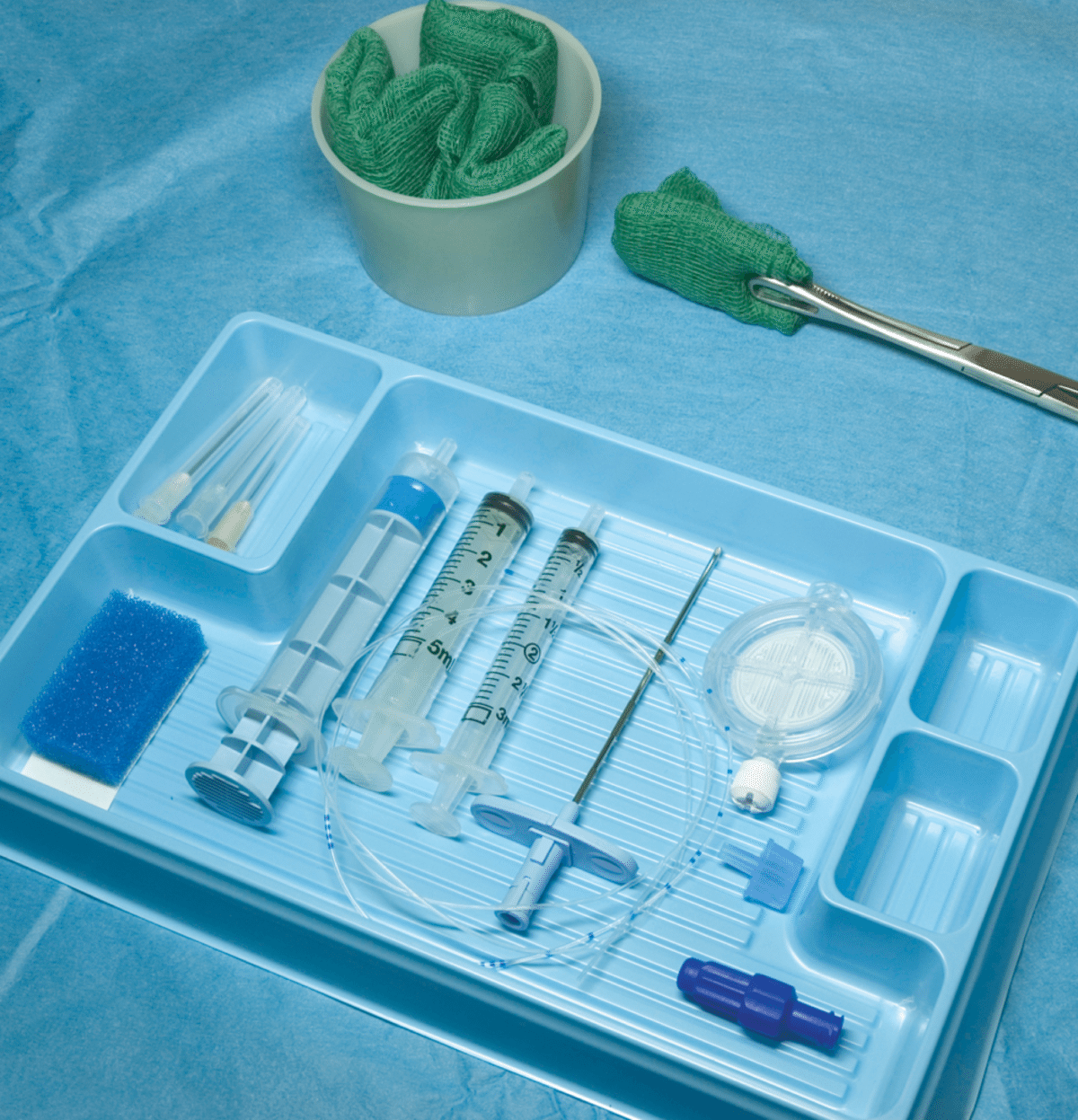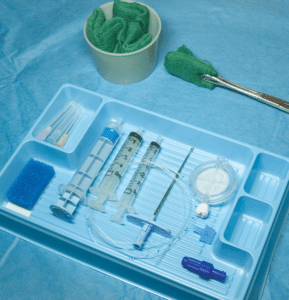You have found out you are pregnant and want to learn as much as you can about birth. When the time comes to visualize your ideal birth you start to wonder about coping with labour pain. Despite your plans to have a natural birth, friends and family encourage you to “just take the epidural”. Every birth you see depicted on TV or in a movie involves an epidural. You start to wonder about epidurals. Will I be able to birth without one? Will it affect my baby? What are the side effects?
In order to make safe, informed decisions for yourself and your baby you need to have the facts about medical interventions. Birthing Magazine is dedicated to providing mothers with the information they need to make informed decisions during pregnancy and birth. We continue our series on common pregnancy and birthing interventions with a look at epidurals.
What is an epidural?
Epidural Anesthesia is an injection of numbing and pain medication into the spine. In Canada only a specially trained doctor (anesthesiologist) can administer epidural anesthesia, and only in a hospital. Some smaller or rural hospitals may not have an anesthesiologist available 24 hours a day.
The anesthesiologist inserts a needle with a catheter (tube) between the spinal bones, into an area called the epidural space, usually around waist level. The needle is removed but the catheter stays in the epidural space and attaches to tubing that allows the medication to flow into the catheter. The medication is delivered through a pump as needed. This is usually a combination of anesthetic and pain relief medication. Each anesthesiologist chooses the preferred combination of medications.
Depending on the dose and type of medication a person may feel slightly numb but be able to walk or be completely free of sensation and unable to move. Some people, about 15%,1, 2 report little to no change in sensations after receiving epidural anesthesia. Once the epidural is removed normal sensations should return within a couple of hours. The use of epidurals for pain management in labour has become so common in hospitals that the Canadian Institute for Health Information has tracked epidural use in labour at rates as high as 70% of births in some regions of Canada. In Alberta, the rate is over 50% and increasing.3
What about risks and side effects?
Before consenting to any medical procedure the medical staff should thoroughly explain the benefits, risks and side effects. Some of the more common side effects of epidural anesthesia are:
- Low blood pressure Intravenous Fluids (IV fluids) are routinely given with epidural anesthesia in an attempt to counteract low blood pressure. Despite IV fluids many women still experience low blood pressure, which can affect the baby’s heart rate and oxygen levels.1, 2, 4 Visit Birthing Magazine online (www.birthingmagazine.ca) for our Spring 2013 article on the effects of IV fluids for mother and baby during birth.
- Urinary retention When a mother is unable to empty her bladder a catheter will be inserted to drain the bladder. This can increase the risk of bladder infection.
- Fever Studies show that women receiving epidurals in labour commonly experience fevers. The cause of the fevers remains undetermined. The presence of a fever in a labouring mother is cause for concern for both the mother and baby, often leading to further medical interventions.
- Pain Pain and bruising at the injection site may occur. About one in 100 people experience post-dural puncture headache after epidural, a painful side effect of leaking cerebrospinal fluid (CSF).6 Although the literature is unclear, back pain in the months following an epidural has been reported.
- Itching, shivering, nausea, vomiting These are all common effects of the medication and IV fluids.1, 2
- Longer labour Studies show that receiving epidural anesthesia in early labour may slow the progression of labour, leading to a greater chance of being augmented with synthetic oxytocin.
What does this mean for my birth?
Once an epidural is administered the medical team will start an IV. The baby’s heart rate will then likely be continuously monitored for changes that commonly occur after epidural.2 With an IV pole and fetal heart monitor strap around her belly it is likely that the mother will be confined to bed. With a low enough dose of medication the mother may be able to walk and move around with assistance, but some anesthetics result in temporary paralysis.1, 2,
With numbed pelvic floor muscles and a non-optimal birthing position the baby may have difficulty descending the birth canal.1, 2 This could be the reason that women who accept epidural anesthesia in birth are more likely to have other interventions, like vacuum extraction or forceps (along with episiotomy) used during birth.1, 2 This can lead to other complications like vaginal and anal tearing or injury to the baby.2 There is also some evidence that the chances of Caesarean birth are more likely.
The use of epidurals interferes with the flow of birth hormones.1, 2 This disruption has many effects, including slowing down labour, causing changes in the baby’s heart rate and even lowering oxytocin, the love hormone, immediately after birth, when it is normally the highest it will ever be in a woman’s life.
What about baby?
The medications that are used in the epidural are shown to cross the placental barrier, meaning the baby is exposed to them in utero.1 Numerous studies point to potential effects on the baby’s nervous system.1, 2 “The drugs are designed to numb sensory nerves in the mother; therefore, they also affect sensory and motor nerves in the infant… that affect rooting, sucking, and breathing. All of these behaviours must be intact for the infant to begin breastfeeding.”7
With a disruption in the mother’s hormones and a baby affected by epidural medication, breastfeeding issues can arise.
Interventions, like Caesarean birth, that follow epidural anesthesia can also have an impact the mother’s ability to breastfeed.2 The literature also shows that, with the support of knowledgeable caregivers, breastfeeding difficulties can be overcome.1 Ask your midwife or lactation consultant for assistance and support if you experience difficulties.
Ways to support your natural birth
Choose a care provider that is knowledgeable about the principles of natural childbirth. Make your choice for natural childbirth known to your care provider and birth support team. Have doula support during birth. It reduces the likelihood of having an epidural.8 Other effective non-pharmacological pain relief strategies include: staying mobile, changing positions, breathing, taking a warm shower or bath, and receiving massage and back pressure.
Insist on full disclosure of information regarding risks and side effects of medical procedures before giving your consent.
Trust your body, trust your baby and trust birth.
Nicole Allarie is a mother to two children, both caught by midwives. She is an advocate for the midwifery model of care and women’s informed choice in childbirth.
- Goer, Henci and Romano, Amy (2012). Optimal Care in Childbirth: The Case for a Physiologic Approach.
- Buckley, Sarah J. (2009). Gentle Birth, Gentle Mothering: A Doctor’s Guide to Natural Childbirth and Gentle Early Parenting Choices.
- Highlights of 2010–2011 Selected Indicators Describing the Birthing Process in Canada. Canadian Institute for Health Information. Accessed June 2013.
- “Childbirth: Epidurals” My Health Alberta. Government of Alberta. Accessed June 2013.
- Segal, Scott MD (2012). “Labor epidural analgesia and maternal fever.” Anesthesia & Analgesia. III (6); 1467-75.
- “Headache after epidural or spinal anaesthetic.“ The Royal College of Anaesthetists. Accessed June 2013
- Smith, Linda and Kroeger, Mary (2010). Impact of Birthing Practices on Breastfeeding. Jones and Bartlett Publishers.
- McGrath, Susan K. PhD, Kennell, John H. MD (June 2008). “A Randomized Controlled Trial of Continuous Labor Support for Middle-Class Couples: Effect on Caesarean Delivery Rates.” Birth: Issues in Perinatal Care. 35: 2; 92–97.



